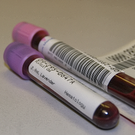Articles tagged with: Heavy Light Chains
NewsFlash »
Velcade-Thalidomide-Dexamethasone Combination May Be Effective After A Stem Cell Transplant In Multiple Myeloma Patients – Results from a French study show that the combination of Velcade (bortezomib), thalidomide (Thalomid), and dexamethasone (Decadron), commonly referred to as VTD, may improve response rates in multiple myeloma patients after stem cell transplantation. The complete response rate for patients who received VTD as a consolidation therapy (52 percent) was significantly higher than the rate for patients who received a placebo (30 percent). The time to progression was also longer in patients who received VTD (62 percent), compared to those who received a placebo (29 percent). All patients had also received VTD as induction therapy prior to stem cell transplantation. For more information, please refer to the letter in the journal Leukemia (abstract).
Revlimid May Not Worsen Pre-Existing Peripheral Neuropathy In Relapsed Or Refractory Myeloma Patients – Results from an Italian study indicate that Revlimid (lenalidomide) does not worsen pre-existing peripheral neuropathy (pain, tingling, and loss of sensation in the extremities due to nerve damage) in relapsed and refractory multiple myeloma patients. The investigators administered Revlimid and dexamethasone to 30 patients who had previously received Velcade or thalidomide. After 12 months of Revlimid therapy, peripheral neuropathy did not worsen in patients with pre-existing peripheral neuropathy and did not develop in any of the patients without pre-existing neuropathy. Based on these results, the investigators recommend longer follow-up studies to confirm Revlimid’s safety in patients with pre-existing peripheral neuropathy. For more information, please see the study in the Journal of the Peripheral Nervous System (abstract).
Heavy/Light Chain Assay May More Effectively Measure M-Protein Levels In Myeloma Patients – Findings from a European study indicate that the heavy/light chain (HLC) assay can be used as an effective prognostic test in patients with multiple myeloma. The investigators found that the HLC assay was better at identifying monoclonal (M) protein levels than other conventional tests, such as serum protein electrophoresis and immunofixation electrophoresis. In addition, the investigators found that the HLC assay was not only more accurate, but could also detect subtle changes in patients with very low M-protein levels. The investigators note that results from the HLC assay and the free light chain (FLC) assay were generally in agreement, but both tests are needed to exclude the presence of residual disease. For more information, please refer to the study in Leukemia (subscription required).
News»

Results of a recent retrospective analysis show that the heavy/light chain test has high potential as a tool for the detection of abnormal monoclonal protein, the evaluation of response to therapy, and as a prognostic marker in multiple myeloma patients.
The heavy/light chain test was more sensitive to low levels of monoclonal (M)-protein compared to conventional detection methods. Thus, the study investigators conclude that the test may become valuable in confirming and quantifying M-protein levels, measuring patient responses to treatment, detecting early signs of relapse, and identifying residual disease in multiple myeloma …
News»

The results of a small Spanish study indicate that heavy/light chain ratios may be a prognostic marker for myeloma patients.
Specifically, the Spanish researchers found that multiple myeloma patients who experienced elevated heavy/light chain ratios after achieving complete remission following a stem cell transplant had longer progression-free and overall survival rates than patients who did not experience elevated heavy/light chain ratios.
According to the study investigators, these results show for the first time the association between a heavy/light chain ratio and sustained remission in myeloma patients.
However, larger follow-up studies may be …

